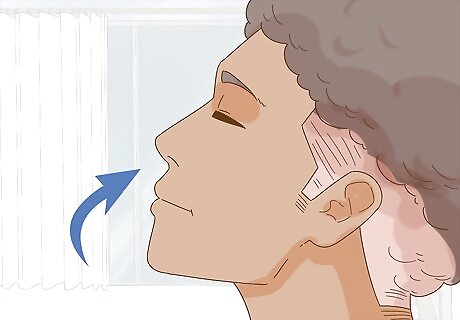
views
Relaxing Your Throat While Singing

Practice “lifting” to strengthen your facial muscles and relax your throat. Lifting is when you slightly lift your cheeks, kind of like you’re smiling but not to an extreme extent. When you sing, aim to keep your cheeks lifted using your zygomatic muscles (the ones that surround your mouth and raise your cheeks when you smile). Maintain this facial position for as long as you can each time you sing to strengthen those muscles. Strengthening the zygomatic muscles pulls them up away from your throat, which in turn will help put less pressure on your throat.Tip: To help yourself with this exercise, try singing in front of a mirror. You’ll visually see when your face starts to relax into a frown.

Inhale a soft “k” to lift your soft palate and lower your larynx. While you’re singing and practicing your “lifting,” start to incorporate a very gently “k” sound every time you inhale. This doesn’t need to be audible to anyone around you, but adding the sound as you inhale will simultaneously lift the soft palate and lower the larynx, which in turn directly helps keep your throat more open than it normally would be. Avoid making a hard “k” sound that would be audible to those around you. Doing so could make your throat tenser and restrict your breathing.

Sing scales while focusing on keeping your throat open and relaxed. You may think that you’re always trying to keep your throat open, but while you are singing scales and changing registers is a prime time when your throat is most likely closing up. During each scale as you approach each register change, remember to lift your cheeks and release any tension in your neck, shoulders, and throat. As you go through the scales, focus on engaging other parts of your body, especially your ribs, intercostal muscles, and lungs. Doing so decreases the tension in your throat and keeps you from injuring it while singing. If you consistently have problems with a closed throat when you hit the higher registers, there may be an issue with the way your larynx is moving. If this is the case for you, meet with a vocal instructor to get some one-on-one training to help resolve this issue.

Move your larynx side-to-side and practice breathing in new positions. Put the back of your hand on the side of your throat and gently push your larynx so it moves to the side slightly. Hold the larynx in place and take 2 to 3 slow breaths, and then move the larynx to the other side and take another couple of deep breaths. This exercise helps open up your throat and stretch your larynx so that it releases tension.
Dealing With Tightness from Anxiety

Practice deep breathing when you’re anxious or panicky. Getting a tight throat or a lump in your throat when you’re anxious is a really common occurrence and it can be an uncomfortable sensation. When you feel your body beginning to tense up and notice the beginning signs of anxiety, take a few minutes to do a few deep breathing exercises. As you take in deep, slow breaths, your throat will begin to relax and your windpipe will expand, helping relieve the tension in your throat. For example, close your eyes and breathe in through your nose for 4 counts. Hold that breath in for another 4 counts, and then exhale through your mouth for 4 counts. Focus on how the air feels entering and exiting your body.

Release tension when you inhale instead of just when you exhale. It’s really common to take in a deep breath and simultaneously tense your shoulders and then release your shoulders on the exhale. This can actually make your anxiety and the tension in your throat worse. Instead, try to keep your shoulders and neck as relaxed as possible when you inhale. Being mindful about doing this, even when you’re at your desk or working throughout the day, can make a big difference in keeping your throat open and relaxed. Focusing on your shoulders will also help take your attention away from your throat. This can give it an opportunity to relax.

Roll your neck from side to side to release your throat muscles. Stretch your neck muscles to help your throat open up and relieve that feeling of tightness. Roll your neck to the side and hold it there for 5 seconds; roll your neck forward, then to the other side, and then backwards, each time holding the pose for 5 seconds. Repeat this 5 to 10 times, or until you start to feel your throat relax. If you feel any pain, stop stretching right away. You should feel a pull in your neck muscles, but there should never be any sharp pain or discomfort.

Exercise to warm up your muscles, including your throat.A great way to release stress and that lump in your throat at the same time is to start moving. Your body will be forced to take in deep breaths of air, and your mind should be distracted by what the rest of your body is doing. When you feel your throat starting to tense up, take a 10 to 20-minute walk around the block, hit the gym, or run up and down a few flights of stairs.Warning: If you feel you’re on the edge of having a panic attack or are starting to hyperventilate, going for a jog isn’t the best course of action. Instead, try some deep breathing to calm yourself down first, and make sure you can take full breaths before exercising.
Resting and Relaxing an Overused Throat

Warm up before you sing or speak to prevent straining your throat. For people who perform, give speeches professionally, or who talk on the phone or to other people all day long, overuse is a very real threat. Do scales, tongue trills, and tongue twisters to get your vocal cords warmed up. Just like with exercise, if you don’t warm up your muscles first and get your blood pumping, you’re likely to injure yourself. The same holds true for using your voice—make the time to warm up to keep your throat in tip-top condition.Tip: Try to spend at least 5 minutes warming up your voice before a performance or a long day of speaking. If you can warm up for 10 minutes, that’s even better!

Practice a yawning stretch to release tension in your throat and jaw. Put your finger across your Adam’s apple (or where your Adam’s apple would be). Start to yawn and notice how your throat moves underneath your finger. As you exhale from the yawn, sigh “ah” at whatever vocal range comes out naturally. Repeat this exercise 5 times, each time focusing on inhaling completely on the yawn and sighing to release the yawn completely. As your throat opens up and your finger gently presses against your throat, your throat muscles will release tension.

Give yourself a chin massage to relax your jaw and stretch your throat. Tilt your head up so that the bottom of your chin is exposed. Take your index and middle fingers on each hand and place them under your chin along your jawline. Massage the area in small circles. Do this for 30 to 60 seconds. For an even greater stretch, stick your tongue out of your mouth as you massage your chin and jaw.

Get a neck and throat massage to keep your throat relaxed. While you can massage parts of your throat and neck yourself, a professional will be able to reach areas that you can’t and can pinpoint problem areas. Schedule a massage once every month (or more often if your throat is often overused or strained), and enjoy knowing that you’re taking good care of your body. Always make sure to hydrate after a massage. Your body releases toxins when you get a massage, and your kidneys need extra hydration to flush those toxins out of your body.

Avoid overusing your voice throughout the day. This isn’t always avoidable, but if you tend to get a tight throat or have been feeling like it’s wearing down, take whatever opportunities you can to rest your voice. For example, don’t sing in the car on your way to work, avoid going to loud places where you have to shout to be heard, and use microphones when you can to speak to large groups. If you work in an industry where you are constantly using your voice and your throat often feels strained, it might be worthwhile to meet with a voice coach. They could give you some great insights into how to rest your throat and keep it from getting damaged.

Rest your throat when it’s strained rather than pushing through. You might be tempted to make yourself work through your pain, but you really risk damaging your throat if you don’t take time to rest. Try gargling with salt water, drink lots of warm water, and avoid speaking, singing, and especially yelling. Rest your throat for 1 to 3 days, depending on how badly it is strained. It’s recommended that you rest your voice for 10 minutes for every 90 minutes of use it gets.When to Visit a Doctor: If your strained throat and hoarse voice persist for over 2 weeks; if it is painful to speak at a normal level after resting your throat for 3 days.



















Comments
0 comment